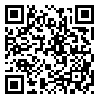BibTeX | RIS | EndNote | Medlars | ProCite | Reference Manager | RefWorks
Send citation to:
URL: http://mjiri.iums.ac.ir/article-1-53-en.html
Abstract
Objective: To evaluate and review our experience with pediatric spinal injuries and
factors affecting outcome, the authors conducted a retrospective clinical study of 43
cases (32 boys, 11 girls) of pediatric spine injuries treated during four years (January
1999 to December 2003).
Methods: Forty-three children with spinal injuries were studied retrospectively
over four years and were divided into two age groups: 0-9 years and 10-17 years. We reviewed the level(s) involved, types of bony injuries, presence of spinal cord injury,
treatment received, length of hospital stay, discharge status, any associated injuries,
and any complications during the hospital stay. Analysis of variance and chi-square
were used to analyze differences between groups.
Results: Motor vehicle accidents were the most common cause in this series. There
were twelve patients aged 0-9 years and thirty-one aged 10-17 years. Spine injury incidence increased with age. There was 14% cervical, 46.5% thoracic, 34.9% lumbar, and 4.6% multilevel involvement. Thirteen patients had spinal cord injury. Spinal cord injury was more common in the 0-9 age group. One patient with spinal cord injury without radiographic abnormality (SCIWORA) was in the 0-9 age group and had complete neurologic injuries. Young children with spinal injuries were more likely to die than older children. The associated injuries were 25.7%. Twenty-five point six percent underwent decompression, fusion, and instrumentation. The complication rate in surgical
patients was higher than in patients treated non-surgically and in multiply injured patients. This may be related to the severity of the initial injury.
Conclusion: Our results suggest age-related patterns of injury that differ from previous
work. Potential for neurological recovery is good. Young children have a higher
risk for death than older children. There was no predominance of cervical injuries in the
young child. The incidence of SCIWORA was low. Higher complication rates were
seen in polytrauma and surgical patients.
| Rights and permissions | |
 |
This work is licensed under a Creative Commons Attribution-NonCommercial 4.0 International License. |





